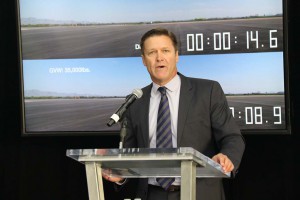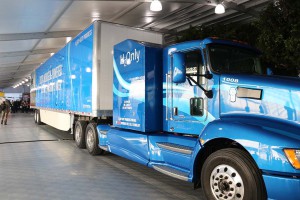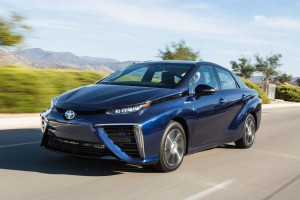Animal waste from the farms of California’s fertile Central Valley will soon be used to fuel up a new generation of ultra-clean cars and trucks, Toyota announced Thursday during a news conference at the Los Angeles Auto Show.
One of the industry’s biggest proponents of fuel-cell vehicles, or FCVs, Toyota hopes the Tri-Gen Project it is setting up at the Port of Long Beach, in suburban Los Angeles, will help overcome the chicken-and-egg problem that has so far limited acceptance of hydrogen power: the lack of a production and distribution network.
“We believe hydrogen technology has the potential to become the powertrain of the future,” said Doug Murtha, a group vice president for strategic planning with Toyota’s North American operations. Adding the project, which will generate 1.2 tons of hydrogen a day, will be “a key milestone in Toyota’s larger commitment to clean mobility.”
Toyota currently has one fuel-cell passenger vehicle on the market, the Mirai. It also has been running a pilot at the Port of Long Beach, using hydrogen-powered semis to replace the diesel trucks considered one of the major transportation sources of pollution in the smoggy L.A. region.
(Toyota gets high marks for environmental practices. For the story, Click Here.)
The biggest challenge for hydrogen proponents is the limited availability of the ultra-light gas. Even with a concerted effort by manufacturers and government groups, there are just 32 publicly accessible stations pumping hydrogen in the entire state of California – a number expected to reach perhaps 100 by the end of the decade. That limits where fuel-cell vehicles can be sold or operated.
Even rolling in hydrogen cars sold by Hyundai and Honda, volumes have been measured in the hundreds a year.
The Tri-Gen project could help set up a process to expand the infrastructure – and address another serious environmental challenge, the flood of manure created by the nation’s factory farms.
(Click Here for more on Toyota’s fuel-cell truck project.)
Hydrogen is the most abundant element in the universe but, on Earth, it is not available as a pure gas. It can be generated in a variety of ways, such as using electricity to electrolyze water or separating it from more complex compounds ranging from natural gas to animal waste. That is the approach Tri-Gen will take, using the methane released as manure breaks down.
“Tri-Gen is a major step forward for sustainable mobility and a key accomplishment of our 2050 environmental challenge to achieve net zero CO2 emissions from our operations,” Murtha said.
The project will produce enough hydrogen to fuel about 1,500 fuel-cell vehicles a day. The equivalent of 2.35 megawatts of electricity, it could alternatively power 2,350 average-sized homes.
(To see more about Toyota’s Fine-Comfort Concept going 620 miles on a tank of hydrogen, Click Here.)
Toyota is partnering with Fuel Cell Energy, with several federal, state and regional government agencies on the Tri-Gen project, as well as the University of California, Irvine.



